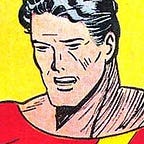The hopeful patchwork horror mythos in ‘The Dark Room’ graphic novel
The Image Comics graphic novel The Dark Room opens with a sinister story: a semi-retired photographer in Depression-era America is driven to suicide in a local newspaper’s dark room after realizing that the film of every photo he takes with his camera — no matter how beautiful the subject — produces only monstrous, horrific images. This bleak tale about a cursed camera initiates a gripping narrative with interesting characters and a rich new mythos that deftly blends folklore with Lovecraftian dread; yet despite its grim opening, The Dark Room is a comic that champions hope amid the horror.
Written by Gerry Duggan, with artwork by Scott Buoncristiano and colorist Tamra Bonvillain, The Dark Room features Dounia Mahoney, a modern-day private curator who specializes in the collection of cursed objects. Mahoney, like her mother before her, has the supernatural ability to see the hidden magical creatures of the world. When a client identifying himself as “Mr. Outis” hires Dounia to find the lost cursed camera, she sees his true form beneath his human disguise.
Although Dounia tells Outis that she will work for him in trying to locate the camera, she actually seeks to learn more about Outis and the camera. In this quest, she is aided by Walt, the skeletal ghost of a former New York City street performer, and her on-again, off-again Irish werewolf boyfriend Aaron, as well as other supernatural allies.
The story hints at a deep narrative history that deserves further exploration. Dounia’s visit to a pub beneath Grand Central Station that caters to the supernatural community offers visual delights, as Buoncristiano and Bonvillain’s artwork provides a menagerie of the strange; each character sparks readers’ questions and desire to know more, and Dounia’s interactions with these characters makes it clear that she is respected in this occult community.
In addition to rendering fantastic creatures and epic confrontations, Buoncristiano deftly portrays the characters’ emotions and personalities, and adds little details for readers to discover as they peruse the panels (like a shadowed depiction of tiny gnomes riding cats in a forest that the protagonists drive through, as an example). Bonvillain is a wonderful artistic partner; her palette helps convey the story’s horror and wonder.
Dounia, Walt, and Aaron have a humorous rapport, but this camaraderie and fun belies the narrative’s horror. Despite Dounia and her friends’ apparent experience and confidence in dealing with supernatural matters, the creative team establishes an atmosphere of dread throughout the story.
The underlying mythos of The Dark Room combines traditional fantasy folklore (elves, unicorns, enchanted swords) and horror (werewolves and vampires), but also the weird fiction tradition of writer H. P. Lovecraft. The iconography of Lovecraftian fiction, such as the appearance of strange tentacles and Cthulhu-inspired monsters, is present, while the story of the cursed camera and its discomfiting images, along with the threat of the fearsome and mysterious Outis, create a disconcerting mood.
In his essay “Supernatural Horror in Literature,” Lovecraft outlines the importance of establishing an atmosphere of dread in horror fiction:
The true weird tale has something more than secret murder, bloody bones, or a sheeted form clanking chains according to rule. A certain atmosphere of breathless and unexplainable dread of outer, unknown forces must be present; and there must be a hint, expressed with a seriousness and portentousness becoming its subject, of that most terrible conception of the human brain — a malign and particular suspension or defeat of those fixed laws of Nature which are our only safeguard against the assaults of chaos and the daemons of unplumbed space.
With Outis, the creative team provides a fascinating and frightening villain that meets Lovecraft’s standards. Outis’s unknown origins, compelling monstrous appearance, and raw power create real stakes for the protagonists, and his actions have a significant impact on Dounia and her friends.
And yet, the mythos of The Dark Room makes it clear that evil cannot withstand qualities such as purity, innocence, and joy. Outis and his forces are repeatedly repelled by the protagonists’ utilization of such virtues — a metaphorical reminder that humanity’s best qualities are a powerful remedy to the world’s troubles.
The creative production of The Dark Room is proof that this narrative conceit applies to reality. In the graphic novel’s backmatter, Duggan discusses the role that his and Buoncristiano’s friend Neil Mahoney — (recall Dounia’s last name) — played in putting them together, a connection that resulted in the creation of The Dark Room. Mahoney passed away prior to the book’s publication.
Duggan acknowledges how making art helps him deal with this tragedy, and others: “…the only thing that makes me feel better is telling the people around me that matter the most that I love them, and most important: continuing to make art that you hope will bring joy.” He adds: “We hope this comic brings you joy. We hope it took your mind off your problems, or reminded you to share something you were supposed to with a friend.”
The Dark Room mixes humor with horror, and blends various supernatural fantasy mythologies into a rich narrative universe that can — and hopefully will — provide an endless number of stories featuring Dounia, along with her friends and enemies. But the graphic novel is also a magical tome, blessing its earnest readers with the certain knowledge that friends, hope, joy, and creativity are the bane of despair.
NOTES AND FURTHER READING:
The Dark Room (Gerry Duggan, Scott Buoncristiano, Tamra Bonvillain, et al.; Image Comics, 2022)
“Supernatural Horror in Literature” by H. P. Lovecraft (1927)
Attention, Secret Dictionary Club members — use Code Thirteen to decipher the following message: BHE ARPEBZNAPREF UNIR PNCGHERQ GUR TUBFG BS PNYVTHYN PNRFNE.
BONUS COMIC STRIP:
The text and images above are the property of their respective owner(s), and are presented here for not-for-profit, educational, and/or review purposes only under the fair use doctrine of the copyright laws of the United States of America.
